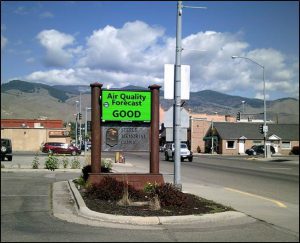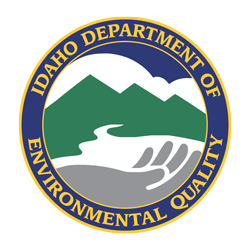Priority areas are geographic sites or regions where air quality is of particular concern. We identify priority areas to allow for a focused effort to improve air quality and engage the community. Once designated as a priority area, regulations or management plans may be developed to protect public health.
Priority area designations are based on several categories, including whether local air quality meets or “attains” the National Ambient Air Quality Standards (NAAQS).
There are several types of priority areas throughout our state:
- Nonattainment areas—Areas that have or are currently violating the NAAQS and have been designated as nonattainment by EPA.
- Maintenance areas—Nonattainment areas that have met all requirements under the Clean Air Act and have been redesignated as attainment areas with a maintenance plan by EPA.
- PM Advance areas—Communities participating in EPA’s PM Advance Program.
- Areas of concern—Areas where the current air quality is approaching NAAQS and the area is experiencing or expecting to see growth.
With the efforts of staff and Idaho communities, there are no nonattainment areas.
Franklin County Partial County —PM2.5
In 2009, EPA designated a portion of Franklin County in southeastern Idaho as nonattainment for the 2006 particulate matter (PM2.5) NAAQS. The Logan, UT/ID nonattainment area includes part of Cache County, Utah. The Cache Valley encompasses a bowl-shaped, topographically isolated valley that experiences wintertime inversions that trap cold air and pollutants near the ground resulting in poor air quality, which can last many days.
Since 2009, DEQ has worked with the local officials and the Franklin County community to improve air quality. Efforts included residential wood heating open burning ordinances and road sanding agreements with the county.
In 2017, DEQ obtained a Targeted Airshed Grant from EPA to address PM2.5 emissions on the Idaho side of this nonattainment area. This grant addresses emissions from residential wood heating and vehicle emissions. See more information on projects funded by this grant.
These efforts proved successful, and in 2018, EPA determined that the area met the 2006 PM2.5 NAAQS and redesignated the area to an attainment area with a maintenance plan in 2021. See the Summary of the Franklin County (Logan Utah/Idaho) PM2.5 Redesignation and Maintenance Plan.
Sandpoint—PM10
Located in Bonner County, the Sandpoint area rests on the northwest corner of Lake Pend Oreille within the Panhandle National Forest. The topography influences much of the particulate matter (PM) buildup in the area. In 1990, the area was designated as nonattainment for the 1987 PM10 NAAQS. Residential wood heating, fugitive road dust, and industrial sources were primary contributors.
Since 1990, the area has made significant improvements in air quality. In 2010, EPA determined that the area met the NAAQS and was redesignated to an attainment area with a limited maintenance plan in 2013. See a Summary of the Sandpoint PM10 Limited Maintenance Plan.
Pinehurst—PM10
The Pinehurst area is located in Shoshone County, near the Coeur d’Alene and St. Joe National Forests. The area’s topography is a significant factor in the buildup of pollutants, including PM10 from residential wood heating and fugitive road dust.
Pinehurst was designated as nonattainment for the 1987 PM10 NAAQS, upon enactment of the Clean Air Act Amendments of 1990. In 1993, EPA expanded the area by designating the Pinehurst PM10 expansion nonattainment area, a contiguous area south of the city, and the existing Pinehurst PM10 NAA.
Since 1993, significant reductions in PM10 emissions resulted in EPA determining both areas met the NAAQS. In 2018, both nonattainment areas were redesignated as attainment with a limited maintenance plan. Both the attainment and maintenance plans rely on control strategies for residential wood heating, including a woodstove changeout program, home weatherization, voluntary woodstove curtailment, and outreach and education. See the Summary of the Pinehurst PM10 Limited Maintenance Plan and Redesignation for additional information.
Portneuf Valley—PM10
The Portneuf Valley encompasses Pocatello, Chubbuck, and surrounding areas and was designated as nonattainment for the 1987 PM10 NAAQS in 1990. It was formerly the Power/Bannock County PM10 area, which was split into the Portneuf Valley and federal Fort Hall PM10 areas. The area is prone to wintertime inversions that trap pollutants near the ground. Road dust, industrial sources, and residential wood heating are the primary emissions sources. Since 1990, significant improvements have been made, and, in 2002, EPA determined the area met the NAAQS. In 2006, the area was designated as attainment with a maintenance plan. See the Summary of the Portneuf Valley PM10 Maintenance Plan for additional information.
Northern Ada County—Carbon Monoxide (CO) and PM10
Northern Ada County was designated nonattainment for CO and PM10 in 1990. The main emission sources for CO are vehicles and area sources, while the main sources for PM10 are fugitive road dust, agriculture, and residential wood heating. Since 1990, the county has made significant improvements and was redesignated to attainment with a maintenance plan for CO and PM10 in 2002 and 2003, respectively. See the Summary of the Northern Ada County (Boise) Second 10-Year Carbon Monoxide Limited Maintenance Plan and the Summary of the Northern Ada County (Boise) PM10 Second 10-Year Maintenance Plan for additional information.
Shoshone County—Partial County—PM2.5
In 2015, northern Idaho’s West Silver Valley was designated as nonattainment for the 2012 PM2.5 NAAQS.
The West Silver Valley is a historic mining area along the South Fork Coeur d’Alene River and includes the communities of Pinehurst, Kingston, Enaville, Smelterville, and Kellogg.
The area is susceptible to frequent inversions in the fall and winter, when fine particulate matter from residential wood heating, open burning, and slash burning becomes trapped and is unable to move out of the area.
For several years, DEQ has partnered with local communities to implement methods to reduce particulate air pollution, including avoiding nonessential open burning and encouraging woodstove users to burn clean.
In 2016, DEQ obtained a Targeted Airshed Grant from EPA to address the West Silver Valley’s PM2.5 emissions from residential wood heating, residential open burning, and slash burning. See more information on the projects funded by this grant.
These efforts were successful and, in 2019, EPA determined that the area met the 2012 PM2.5 NAAQS.
In June 2020, DEQ submitted a Maintenance Plan and Redesignation Request to EPA.
These efforts were successful and, in 2019, EPA determined that the area met the 2012 PM2.5 NAAQS. In December 2021, EPA redesignated the area to an attainment area with a maintenance plan.
See the West Silver Valley Fine Particulate Matter Maintenance Plan for additional information.
EPA launched the PM Advance Program in 2013. This voluntary program encourages collaboration between EPA, states, tribes, local government, and communities to proactively reduce emissions in areas struggling to meet national air quality standards for PM2.5. The program empowers local communities to develop site-specific solutions to air quality problems that fit local needs and goals.
Salmon
Salmon’s air quality is impacted by intense smoke events from regional  wildfires in the summer and smoke from residential wood heating and wintertime inversions that trap cold air and pollutants near the ground. The design value for the Salmon airshed has been above the 2006 PM2.5 NAAQS since 2011. The PM Advance Program provided a way for the community to develop an acceptable path toward improving local air conditions and enhancing the quality of life.
wildfires in the summer and smoke from residential wood heating and wintertime inversions that trap cold air and pollutants near the ground. The design value for the Salmon airshed has been above the 2006 PM2.5 NAAQS since 2011. The PM Advance Program provided a way for the community to develop an acceptable path toward improving local air conditions and enhancing the quality of life.
In 2018, Salmon, in partnership with DEQ, committed to improving air quality and developed a path forward. The measures and strategies outlined in the PM Advance Path Forward are critical for improving air quality. The city’s plan focuses on expanding outreach and education efforts to increase knowledge of local air quality and efficient woodstove use.
DEQ, in coordination with the local hospital, installed an electric sign that promotes education. See resources available to upgrade your woodstove.
St. Maries
St. Maries, located in Benewah County in northern Idaho, has experienced poor air quality since 2014. Air quality is impacted by residential wood heating in the fall and winter, wildfires, and prescribed burning in the summer and fall, and general open burning throughout the year. In 2020, St. Maries, in partnership with DEQ, committed to improving air quality by joining the PM Advance Program. The resulting PM Advance Path Forward outlines measures and strategies to improve air quality in the area.
Treasure Valley (Ada and Canyon Counties)—PM2.5 and Ozone
The Treasure Valley is the largest and most populated area in Idaho. The majority of the valley’s population and the emission sources are concentrated in Ada and Canyon Counties.
DEQ is working to coordinate efforts among citizens, businesses, and government agencies to manage air pollution and improve public awareness of air quality conditions and associated health risks.
The Treasure Valley is subject to wintertime inversions that trap cold air and pollutants near the ground that result in poor air quality. During these events, air quality monitors in the valley have recorded levels above PM2.5 NAAQS.
The valley experiences air quality problems in the summer as well. Calm wind, high temperatures, and intense sunlight produce unhealthy accumulations of ozone near the ground. Air quality monitoring has shown levels of ozone in the valley, sometimes at unhealthy air quality levels, during the past several summers.
Vehicles are one of the main sources of emissions in the valley that can increase both PM2.5 and ozone. See what is being done to address vehicle emissions.
DEQ is also coordinating efforts among citizens, businesses, and government agencies to manage air pollution and improve public awareness of air quality conditions and health risks.

